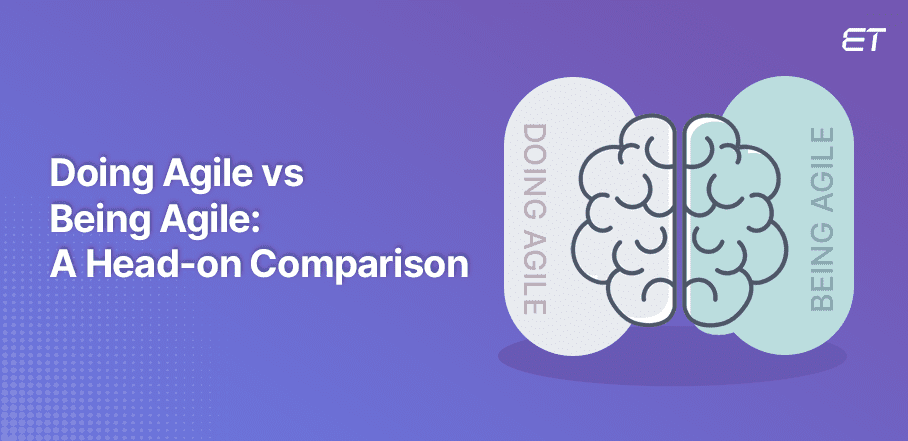Ever feel like your team is using tools like sticky notes and leveraging stand-up meetings, but the project is stuck? If yes, understanding the doing agile vs being agile comparison can prove invaluable.
A colossal difference exists between ‘doing’ and ‘being’ agile.
In this blog, we will elaborate on the distinguishing factors. By the end of reading this piece, you can make better decisions when choosing a software development partner. How?
You will understand whether a prospect showcases agile without aligning with the core principles. So, scroll ahead to understand what it is to do agile vs be agile!
What Does ‘Doing Agile’ Mean?
‘Doing Agile’ refers to implementing the practices associated with agile methodologies.
In other words, this concept implies that you practice specific steps without understanding the ‘why’ behind them. Here are some main activities that fall under ‘doing agile.’
1. Implementing Agile Frameworks
Popular frameworks like Scrum and Kanban provide specific structures and workflows. ‘Doing agile’ implies adopting these frameworks and their associated formalities.
For instance:
In scrum, teams work in short sprints (usually 2-4 weeks) to deliver working software increments. Daily stand-up meetings, sprint planning sessions, and sprint reviews are the cornerstones of project management
In Kanban, tasks are represented on a board, moving through stages like ‘to-do,’ ‘in progress,’ and ‘done.’
2. Focusing on Processes
By ‘doing agile,’ teams become familiar with specific rituals and meetings. Daily stand-ups ensure information sharing. Further, sprint planning sessions define goals for the upcoming iteration. These activities can seem valuable for an organization.
However, ‘doing agile’ can rely highly on these processes without considering their purpose.
In this process, the focus shifts towards completing tasks and meeting deadlines. However, this constrained emphasis can overlook the quality of work or its value to the customer.
3. Tools and Technologies
You can use several tools to support agile practices. Project management software, communication platforms, and digital task boards are popular in ‘doing agile.’
However, without considering the core philosophies, teams can rely on these tools without recognizing that they are just auxiliary units.
The Four Major Drawbacks of Doing Agile
| High focus on instant outcomes over process | Teams cannot respond to changing requirements. |
| Platform-Specific Projects | Meeting deadlines is the main priority over delivering value to the customer. |

Understanding the Term ‘Being Agile’
This term goes beyond the mechanics and formalities of processes. Adopting a flexible and adaptable mindset that aligns with the core principles of agile philosophies makes a significant difference.
These elements make the latter more effective in the doing agile vs being agile comparison.
1. Emphasis on Core Values
Agile is not a methodology that focuses on tools or processes. Yes, these components make the entire philosophy more seamless. However, a true agile spirit is about empowered teams.
Being agile includes open communication, collaboration, and effective brainstorming. In this approach, customer feedback becomes the driving force to ensure the software is meeting evolving needs.
2. High Focus on the Target User
Today, waterfall development with single deliverables is rare. Agile teams actively involve customers throughout the process to ensure features are relevant and deliver value.
In addition, agile teams are adaptable and see change as an opportunity to improve. All in all, being agile is a philosophy. Teams constantly learn from their experiences, refine their processes, and try to deliver more excellent value with each iteration.
The Four Main Benefits of Being Agile
| Teams become more flexible and can optimize workflows as per client needs | Regular customer feedback ensures more relevant features and satisfied users |
| The main focus is on iteration and customer feedback, leading to continuous improvement. | There is a rise in engagement and productivity due to seamless collaboration. |
Doing Agile vs Being Agile: Fundamental Differences
You might agree that agile software development methodologies enhance project management. However, several vendors can claim to implement agile.
That’s when you need to know the fundamentals of doing agile vs. being agile in the faceoff. This section explains the key aspects that differentiate the two terms.
Focus
| Doing Agile | Being Agile |
| The emphasis lies on following the established structures of frameworks like Scrum or Kanban | The core values of Agile, such as collaboration, continuous improvement, and customer focus, become the main facets. |
| Daily stand-up meetings, sprint planning sessions, and backlog management tools become essential while executing projects. | Tools and processes are facilitators. They do not dictate the entire methodology |
Mindset
| Doing Agile | Being Agile |
| Teams strictly adhere to pre-defined workflows. This rigidity hinders flexibility and creativity. | This term embraces ‘change’ and perceives it as an opportunity to exert a positive impact. |
| Professionals can perceive changes in requirements as disruptions to the established plan | Teams are comfortable optimizing workflows as per the requirement |
Output Expectation
| Doing Agile | Being Agile |
| Completing tasks and meeting deadlines are the primary objectives. | Delivering functional features that address customer needs is vital. |
| The quality of work or its value to the customer can become secondary considerations. | Being agile prioritizes working software, ensuring the delivery of continuous value. |
Teamwork and Communication
| Doing Agile | Being Agile |
| Team interaction can become limited to set meetings like stand-ups or sprint reviews. | Open communication and collaboration become built into the team culture |
| The focus can shift toward completing individual tasks within the defined process. | Stakeholders value diverse perspectives, and team members work together to solve problems to achieve common goals. |
How to Move from Doing to Being?
By now, you must be aware of one or more of the following points:
- Your team is stuck in ‘doing agile.’
- IT vendors make the agile claim but fail to produce outstanding results.
The doing agile vs being agile comparison can empower you to identify and act. Since we have covered the ‘identification’ part, let us move towards how to transition from ‘doing’ to ‘being.’

1. Change Your Focus
Start by embedding the core agile values:
- Individuals
- Interactions
- Working software
- Customer collaboration
- Responding to change
These values become the guiding principles for your team’s actions.
Next, focus on delivering value to the customer, not just completing tasks. Regularly gather customer feedback and ensure features align with their needs.
2. Practice Kaizen
Proper planning and introspection can help identify areas for improvement and experiment with new approaches. One should perceive failures as learning opportunities.
Encourage open discussions about challenges and how to overcome them in the future.
You can foster collaboration across team members with different skill sets. Encourage knowledge sharing and cross-functional problem-solving for the best results.
3. Collaborate and Communicate
You should move away from individual task ownership and promote a sense of shared responsibility for the project’s success. This approach fosters a more collaborative environment.
Also, you should encourage open communication across all levels – within the team, with stakeholders, and with customers. Regular feedback loops ensure everyone is on the same page.
4. Adapt Fast
Doing agile vs being agile can seem daunting at first. However, you should not be afraid to adapt and meet your project’s specific needs. Encourage a culture of trying new things. Experiment with different methodologies, learn from successes and failures and optimize your processes.
Remember this – going from ‘doing’ to ‘being’ is a continuous process. So, you should adopt the mindset rather than implementing mechanical processes.



Doing Agile vs Being Agile: Common Misconceptions
You might have some misconceptions about doing agile vs being agile. In this section, we will debunk all the myths.
Rather than explaining each point as a separate heading, here is a table that can help you understand the myths at a glance.
| Myth | Reality |
| Being agile means going with the flow | Adopting agile principles emphasizes flexible planning. The best teams engage in frequent, iterative planning sessions that adapt to project requirements |
| Agile mostly focuses on speed | Being agile prioritizes value delivery over brisk output with compromised quality. Teams focus on delivering features that contribute to the project’s overall success. |
| Documentation is not a major aspect of agile | The best agile teams focus on creating the right document at the right time. They use clear communication channels to share functional specifications for high transparency |
| Agile guarantees the highest ROI | Being agile can be a powerful way to develop software. However, it is not a magic wand. Relentless commitment and an agile culture are necessary for achieving success through this methodology. |
To Wrap Up: Doing Agile vs Being Agile
There is no one-size-fits-all recipe for success in project management. Agile is a broad term that can seem overly popular today.
However, comparing doing agile vs being agile can help you understand the vital nuances. By embracing the core values of collaboration, flexibility, and continuous learning, you can move beyond ‘doing agile’ and towards ‘being agile.’
Set your focus straight, practice continuous improvement, collaborate, and adapt quickly to changing requirements. Remember, being agile is a journey that requires your team members to be on the same page.
If you want to save time, partnering with an IT vendor that understands the differences between doing agile vs being agile can prove conducive. So, ensure you choose a reliable software development partner to benefit from the true agile philosophy.
Frequently Asked Questions: Doing Agile vs Being Agile
1. How can you measure the success of being agile?
There is no single metric to measure the success of ‘being agile.’ However, you can understand if you are on the right track by analyzing customer satisfaction, team morale, time to market, and quality.
2. Can agile work for small teams?
Yes. You can adapt agile frameworks to manage your workflows and prioritize tasks. Being agile is about cultivating an apt mindset and smartly responding to project changes.
Excellence-driven professional with 15+ years of experience in increasing productivity, and revenue, while effectively managing products of all sizes. He has worked for international clients in the US, UK, and Singapore and local companies in various domains. With excellent attention to detail and a methodical approach to execution, he is an expert in bringing projects to a successful stage. He follows James Humes’s famous saying- “The art of communication is the language of leadership.”









